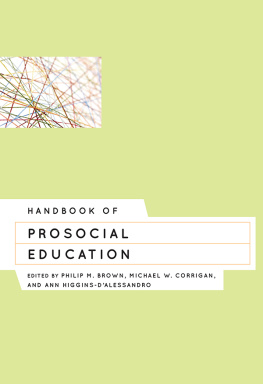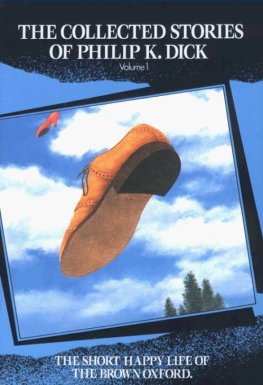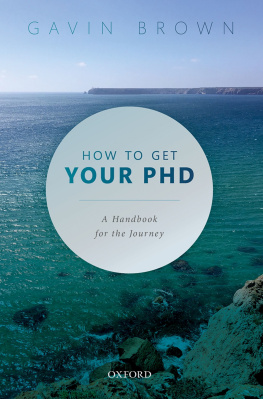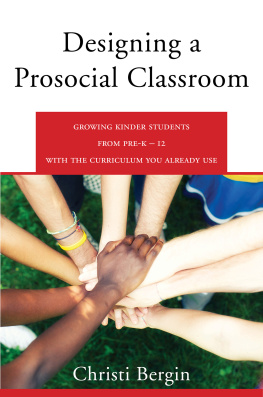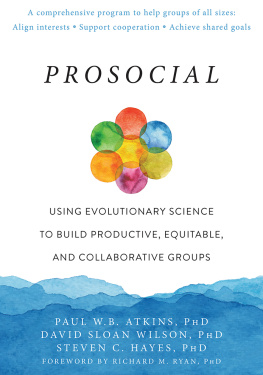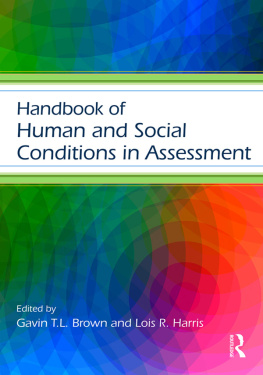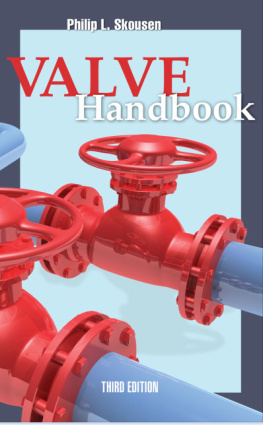Brown Philip M. - Handbook of Prosocial Education
Here you can read online Brown Philip M. - Handbook of Prosocial Education full text of the book (entire story) in english for free. Download pdf and epub, get meaning, cover and reviews about this ebook. year: 2012, publisher: Rowman & Littlefield Publishers, genre: Children. Description of the work, (preface) as well as reviews are available. Best literature library LitArk.com created for fans of good reading and offers a wide selection of genres:
Romance novel
Science fiction
Adventure
Detective
Science
History
Home and family
Prose
Art
Politics
Computer
Non-fiction
Religion
Business
Children
Humor
Choose a favorite category and find really read worthwhile books. Enjoy immersion in the world of imagination, feel the emotions of the characters or learn something new for yourself, make an fascinating discovery.
- Book:Handbook of Prosocial Education
- Author:
- Publisher:Rowman & Littlefield Publishers
- Genre:
- Year:2012
- Rating:4 / 5
- Favourites:Add to favourites
- Your mark:
- 80
- 1
- 2
- 3
- 4
- 5
Handbook of Prosocial Education: summary, description and annotation
We offer to read an annotation, description, summary or preface (depends on what the author of the book "Handbook of Prosocial Education" wrote himself). If you haven't found the necessary information about the book — write in the comments, we will try to find it.
Handbook of Prosocial Education — read online for free the complete book (whole text) full work
Below is the text of the book, divided by pages. System saving the place of the last page read, allows you to conveniently read the book "Handbook of Prosocial Education" online for free, without having to search again every time where you left off. Put a bookmark, and you can go to the page where you finished reading at any time.
Font size:
Interval:
Bookmark:
Handbook of Prosocial Education
Edited by Philip M. Brown, Michael W. Corrigan, and Ann Higgins-DAlessandro
ROWMAN & LITTLEFIELD PUBLISHERS, INC.
Lanham Boulder New York Toronto Plymouth, UK
Published by Rowman & Littlefield Publishers, Inc.
A wholly owned subsidiary of The Rowman & Littlefield Publishing Group, Inc.
4501 Forbes Boulevard, Suite 200, Lanham, Maryland 20706
www.rowman.com
10 Thornbury Road, Plymouth PL6 7PP, United Kingdom
Copyright 2012 by Rowman & Littlefield Publishers, Inc.
All rights reserved . No part of this book may be reproduced in any form or by any electronic or mechanical means, including information storage and retrieval systems, without written permission from the publisher, except by a reviewer who may quote passages in a review.
British Library Cataloguing in Publication Information Available
Library of Congress Cataloging-in-Publication Data
Handbook of prosocial education / edited by Philip M. Brown, Michael W. Corrigan, and
Ann Higgins-DAlessandro.
p. cm.
Includes bibliographical references and index.
ISBN 978-1-4422-1119-3 (hardback) ISBN 978-1-4422-1121-6 (electronic)
1. Affective educationHandbooks, manuals, etc. 2. Moral educationHandbooks, manuals, etc. 3. Social learningHandbooks, manuals, etc. 4. School improvement programsHandbooks, manuals, etc. I. Brown, Philip M., 1942 II. Corrigan, Michael W.
III. Higgins-DAlessandro, Ann.
LB1072.H36 2012
370.15'3dc23
2012008990
 The paper used in this publication meets the minimum requirements of American National Standard for Information SciencesPermanence of Paper for Printed Library Materials, ANSI/NISO Z39.48-1992.
The paper used in this publication meets the minimum requirements of American National Standard for Information SciencesPermanence of Paper for Printed Library Materials, ANSI/NISO Z39.48-1992.
Printed in the United States of America
Foreword
This very important volume underscores what thoughtful people have long knownthat there is more to education than achieving high scores on tests. The best schooling not only helps children to live satisfying lives in the present but also prepares them for full personal, occupational, and civic lives in the future. A sound education attends to physical, social, emotional, and moral development as well as intellectual growth in all three of these great life domains.
Despite knowledge gained over the centuries about the connections among social, emotional, moral, and intellectual development, we now work in an educational environment that puts inordinate stress on narrowly defined academic objectives, and the main goal of achieving them is posited as well-paying jobs in the future for individuals and economic competitive advantage for the nation. Without denigrating these goals, we should worry that something is missing. Education for personal life is almost ignored, and that for civic life has very nearly deteriorated to an accumulation of facts in history and geography. This volume should encourage readers to push back against this current unhealthy trend and work to find ways to renew dialogue on genuine education for whole persons and whole communities.
Reader-practitioners will find a host of promising ideas and research-tested programs here. In keeping with the spirit of the book, however, I would warn readers against buying any one program whole hog. Programs that have worked well in one setting may or may not work well in another. Generally, what has made them work is a shared attitude conducive to prosocial education together with a cooperative spirit, a willingness to work together in a responsible, exploratory way. Intelligent, committed educators should be wary of the current mania for scaling upfinding a method or approach that can be used as an all-purpose recipe. A great deal can be learned from each of the programs and approaches described here, but simply copying them will very likely reduce their power.
Teachers can use dilemmas from the Kohlbergian approach, heroic tales from character education, stories that require logical thinking from Philosophy for Children, ideas from programs in critical reading, and approaches such as Facing History and Ourselves, civic education, and multicultural education. But should there not be some consistency? I am not suggesting that educators simply grab bits here and there and throw them together haphazardly. We should be consistent in our dedication to teaching the whole childevery childand consistent in maintaining a climate in which relations of care and trust flourish. From that foundation, we can choose widely and wisely.
If we are serious about educating the whole child, we must try to avoid piecemeal approaches and work toward the integration of aims and interests across the curriculum and school organization, as the editors of this volume advocate. When art is confined to art class, moral concerns to a class on character education, literature to English class, and so on, the curriculum quickly becomes overcrowded, and competition for time becomes keen. Under such circumstances, we all know which topics will be discarded or set aside. We have to move beyond the add-a-course response to perceived needs. Reading some stories told here on the effective implementation of powerful programs, readers should ask how the essence of these programs can be maintained in increasingly crowded school days. These fine programs are already at risk of being dropped in favor of courses or units more narrowly directed at traditional learning objectives and higher test scores. There are two ways to address this risk: one is to show convincingly that the prosocial program under consideration actually leads to higher test scores, and several of the programs described here seem to do this; the other way is to incorporate the ideas and processes of the prosocial work so carefully and completely into traditional courses that they become virtually invulnerable. Many of the chapters in this volume advocate this approach. Watch for these possibilities!
The second mode of promoting prosocial education is especially important at the secondary school level, where any add-on is likely to be short-lived. For a long time, it was thought that an education in the liberal arts would meet the full range of needs across all three life domains for societys leading citizens. Such an education, it was claimed, would produce good character, wisdom (and therefore professional competence), and civic responsibility. This claim is still being argued at the university level even as interest in the liberal arts fades. If the claim is true, then we haveby reducing the emphasis on the liberal artslet a promising mode of integrated, prosocial education slip away from us.
However, whether the claim for liberal education was justified is irrelevant today, because the disciplinesat least at the secondary levelare so narrowly defined that they rarely make connections even to each other, much less to life in all three great domains. This, I think, is where the current volume on prosocial education contributes so much. Instead of asking what a course in prosocial education should look like, it encourages us to ask, what can a course in mathematics (or science, history, etc.) contribute to prosocial education? How can such a course be connected to other subjects that students are required to study? How can it be related to ethics, religion, art, philosophy, and literature? What methods might the teacher employ to encourage cooperative activity, a sense of civic responsibility, appreciation for diverse talents, and commitment to intellectual honesty? The chapters you are about to read should induce some rich thinking on these questions.
Finally, I hope that the work described here will lead to thinking seriously about what can be done not only for the present generation of young people but for future generations. When we consider the list of problems faced by our young people today, we should think about how to prevent some of these problems for their children and grandchildren. We know that many of todays problems can be traced to poor or ineffective parenting. We know also that parenting plays a huge role in most adult lives; it is part of the personal domain for which students should be prepared. Why, then, do we not teach parenting in our schools? I have already warned against the usual response of adding a course. Instead, I would ask teachers of the traditional disciplines to respond to the questions posed above as they apply to parenting as part of prosocial education. If we succeed at this, future prosocial educators might need to spend less time on problems of bullying, truancy, cheating, addiction, and a host of other ills afflicting our kids, and more time preparing students for full lives in the three great domains of human life: personal, occupational, and civic.
Font size:
Interval:
Bookmark:
Similar books «Handbook of Prosocial Education»
Look at similar books to Handbook of Prosocial Education. We have selected literature similar in name and meaning in the hope of providing readers with more options to find new, interesting, not yet read works.
Discussion, reviews of the book Handbook of Prosocial Education and just readers' own opinions. Leave your comments, write what you think about the work, its meaning or the main characters. Specify what exactly you liked and what you didn't like, and why you think so.

